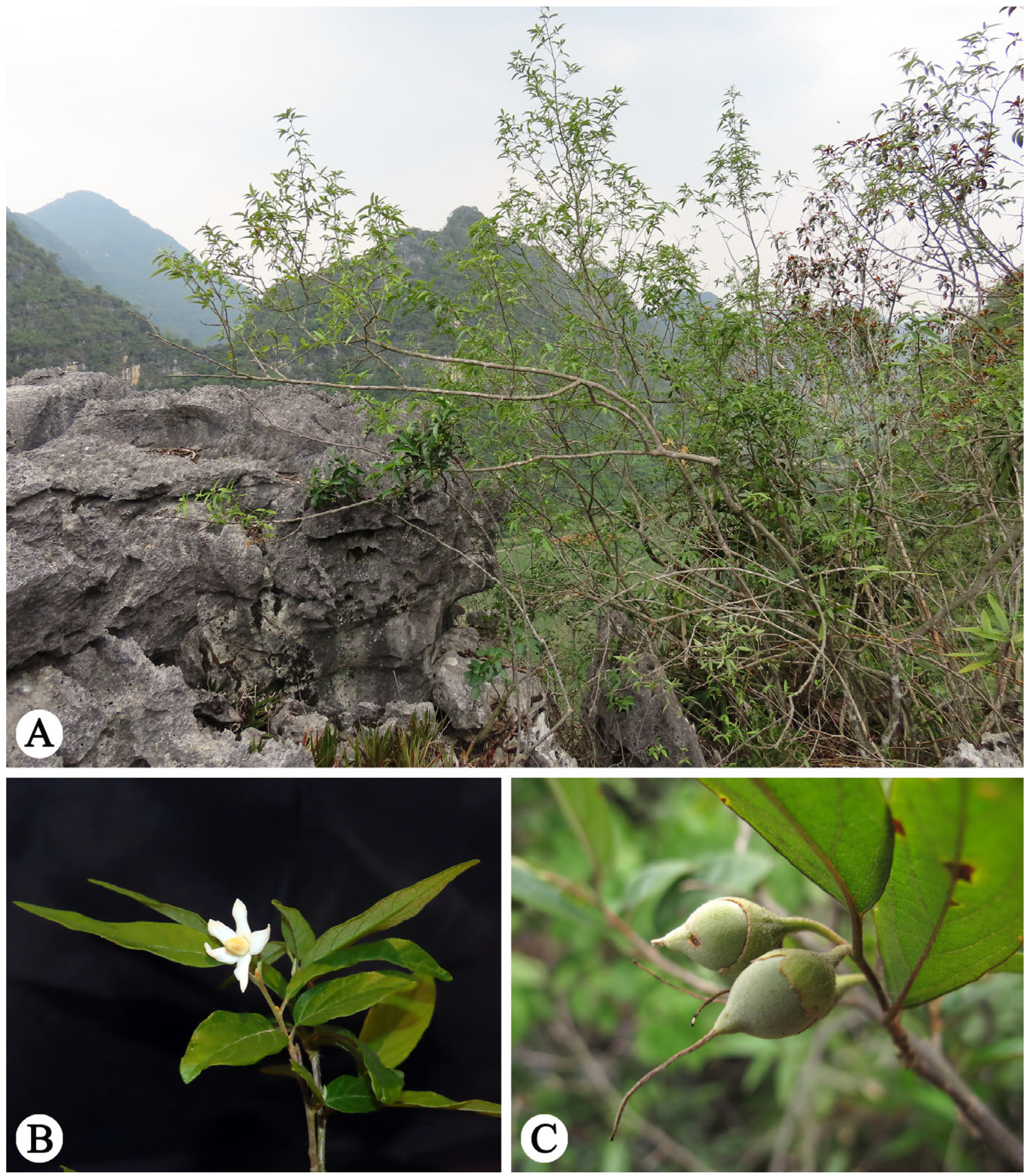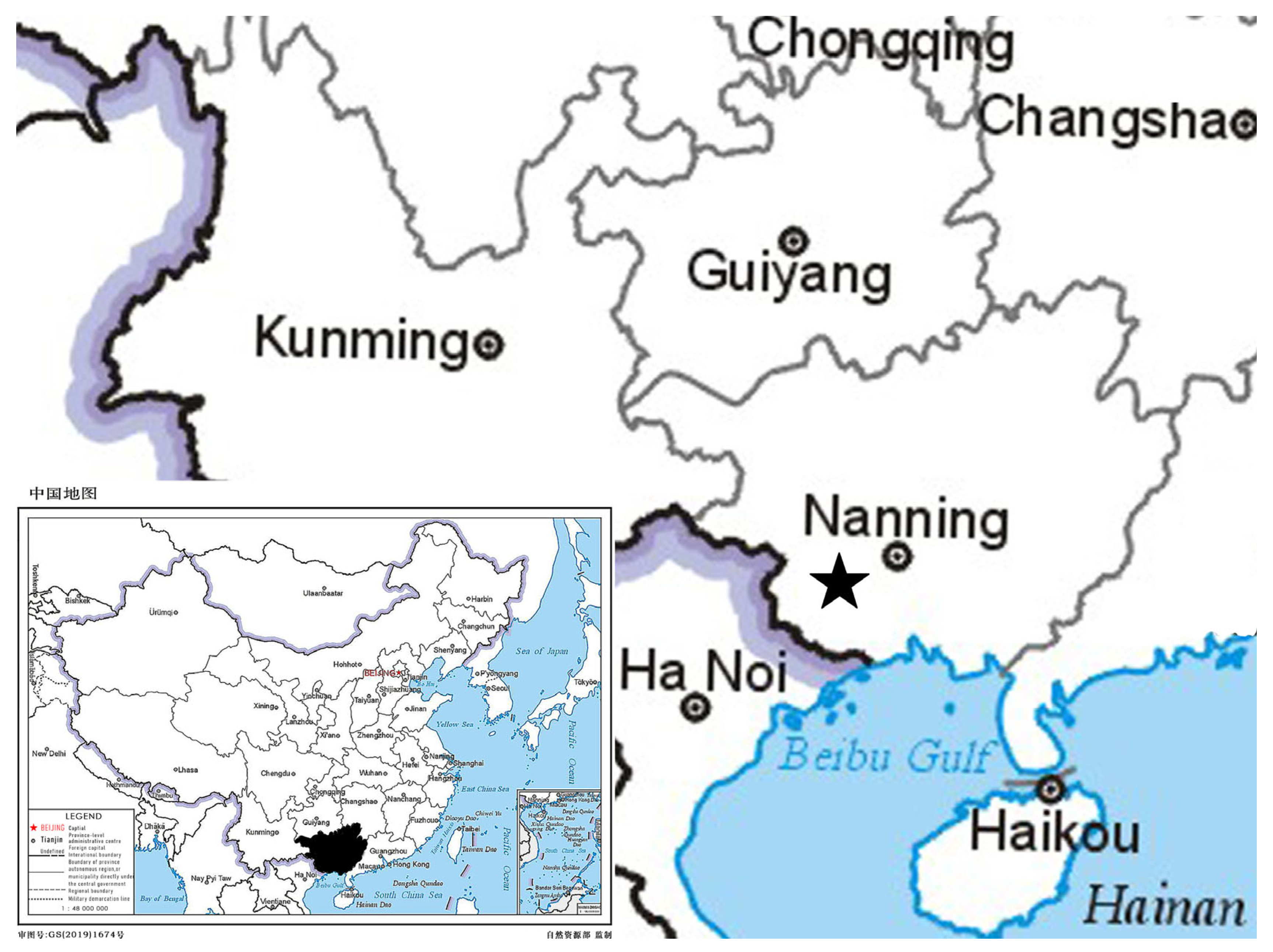Morphological and Molecular Evidence for a New Species Within Styrax (Styracaceae) from a Karst Area in Southwest Guangxi, China
Abstract
1. Introduction
2. Methods and Material
2.1. Morphological Analysis
2.2. Species Sampling, DNA Extraction, and Data Collection
2.3. Phylogenetic Analysis
3. Results
3.1. General Morphology
3.2. Phylogenetics
4. Taxonomic Treatment
5. Notes
Author Contributions
Funding
Data Availability Statement
Acknowledgments
Conflicts of Interest
Appendix A
| Accession No. | Taxon | Voucher Information | Herbarium |
|---|---|---|---|
| * | Styrax chongzuoensis | Xu WB et al., 14236 | JXAU |
| MT644192 | Styrax agrestis | Poilane E., #18626 | P |
| PQ276582 | Styrax argentifolius | W. T. Tsang, #30238 | A |
| PQ276583 | Styrax buchananii | Buchanan, E.M., #51 | E |
| MN560141 | Styrax calvescens | A. Henry, #721 | A |
| MT648752 | Styrax chinensis | - | - |
| MT700478 | Styrax confusus | A. Henry, #3450 | A |
| MT700479 | Styrax dasyanthus | C. Silvestri, #1770 | A |
| MN335255 | Styrax faberi | H. F. Hance, #13738 | GH |
| PQ276585 | Styrax finlaysonianus | - | - |
| MZ285742 | Styrax formosanus | - | - |
| MN733525 | Styrax hemsleyanus | Wilson, E.H., #2574a | HBG |
| PP853567 | Styrax japonicus | Nebel, O., #Herb. J. Goltz s.n. [1900-05-25] | JE |
| MN560143 | Styrax obassia | - | - |
| MN368610 | Styrax odoratissimus | Champion, J.G., #138 | K |
| MZ285734 | Styrax perkinsiae | E. H. Wilson, #2576 | A |
| NC041138 | Styrax ramirezii | Pringle, C.G., #6848 | G/K |
| PQ066665 | Styrax rhytidocarpus | - | - |
| MZ152917 | Styrax serrulatus | s.coll., #s.n. | K |
| MZ285747 | Styrax suberifolius | P. G. Farges, #1487 | A |
| MZ285744 | Styrax tonkinensis | Augustine Henry, #12006 | MO |
| OP581012 | Styrax wuyuanensis | - | - |
| MF770705 | Symplocos ovatilobata | F. C. How, #71750 | A |
| MG719832 | Symplocos paniculata | Siebold, PF von, #s.n. | L |
References
- Fritsch, P.W. Phylogeny of Styrax based on morphological characters, with implications for biogeography and infrageneric classification. Syst. Bot. 1999, 24, 355–378. [Google Scholar] [CrossRef]
- Li, G.; Fritsch, P.W. A taxonomic revision of taxa in Styrax series Cyrta (Styracaceae) with valvate corollas. J. Bot. Res. Inst. Texas. 2018, 12, 579–641. [Google Scholar] [CrossRef]
- Xu, W.B.; Yang, P.; Huang, Y.S.; Zhang, R.; Tang, M. Styrax hwangiae (Styracaceae), a new species endemic to limestone areas of Guangxi, China. Phytotaxa 2021, 478, 171–178. [Google Scholar] [CrossRef]
- Hwang, S.M.; Grimes, J. Styrax L. In Flora of China; Wu, Z.Y., Raven, P.H., Eds.; Science Press: Beijing, China; Missouri Botanical Garden Press: St. Louis, MO, USA, 1996; pp. 253–263. [Google Scholar]
- Zhou, H.; Yang, W.; Li, M.; Yu, X.L. Styrax rhytidocarpus (Styracaceae), a new species from Hunan, China. Phytotaxa 2015, 230, 87–91. [Google Scholar] [CrossRef]
- Huang, Y.L.; Fritsch, P.W.; Shi, S.H. A revision of the imbricate group of Styrax series Cyrta (Styracaceae) in Asia. Syst. Bot. 2003, 90, 491–553. [Google Scholar] [CrossRef]
- Ruan, Y.Q.; Yu, Y.L.; Yu, F.; Deng, X.G.; Liu, Y.L.; Wu, X.H.; Tang, M. Reinstatement of the Chinese endemic species Styrax zhejiangensis. Phytotaxa 2019, 133, 105–113. [Google Scholar] [CrossRef]
- Zhang, R.; Zhao, W.; Liu, Y.; Fan, Y.; Tang, M. Rediscovery of Styrax buchananii and S. chrysocarpus, with supplemental descriptions adding fruit and floral characters, respectively. Phytotaxa 2021, 479, 173–182. [Google Scholar] [CrossRef]
- Zhang, R. Taxonomic Studies of Styrax in China. Master’s Thesis, Jiangxi Agriclutural University, Nanchang, China, 2022. [Google Scholar]
- Zhang, C. The Resources and Landscape Utilization of Styracaceae in Hunan. Master’s Thesis, Central South University of Forestry and Technology, Changsha, China, 2011. [Google Scholar]
- Huang, L.H. Benzoinum Medicinal Material Quality Analysis and Pharmacokinetic Studies of Benzoic Acid in Rats. Master’s Thesis, Chengdu University of Traditional Chinese Medicine, Chengdu, China, 2011. [Google Scholar]
- Ho, P.H. An Illustrated Flora of Vietnam; Youth Publisher: Ho Chi Minh, Vietnam, 1999; Volume 1, pp. 659–662. [Google Scholar]
- Bolger, A.M.; Lohse, M.; Usadel, B. Trimmomatic: A flexible trimmer for Illumina sequence data. Bioinformatics 2014, 30, 2114–2120. [Google Scholar] [CrossRef]
- Wick, R.R.; Schultz, M.B.; Zobel, J.; Holt, K.E. Bandage: Interactive visualization of de novo genome assemblies. Bioinformatics 2015, 31, 3350–3352. [Google Scholar] [CrossRef]
- Jin, J.J.; Yu, W.B.; Yang, J.B.; Song, Y.; Depamphilis, C.W.; Yi, T.-S.; Li, D.-Z. GetOrganelle: A fast and versatile toolkit for accurate de novo assembly of organelle genomes. Genome Biol. 2020, 21, 241. [Google Scholar] [CrossRef]
- Wu, X.; Jiang, M.; Shi, L.; Liu, C.; Huang, L.; Wang, L.; Chen, H. CPGAVAS2, an integrated plastome sequence annotator and analyzer. Nucleic Acids Res. 2019, 47, W65–W73. [Google Scholar] [CrossRef]
- Katoh, K.; Standley, D.M. MAFFT multiple sequence alignment software version 7: Improvements in performance and usability. Mol. Biol. Evol. 2013, 30, 772–780. [Google Scholar] [CrossRef] [PubMed]
- Nguyen, L.T.; Schmidt, H.A.; Von Haeseler, A.; Minh, B.Q. IQ–TREE: A fast and effective stochastic algorithm for estimating maximum–likelihood phylogenies. Mol. Biol. Evol. 2015, 32, 268–274. [Google Scholar] [CrossRef] [PubMed]
- Kalyaanamoorthy, S.; Minh, B.; Wong, T.; von Haeseler, A.; Jermiin, L. ModelFinder: Fast model selection for accurate phylogenetic estimates. Nat. Methods. 2017, 14, 587–589. [Google Scholar] [CrossRef]
- Ronquist, F.; Teslenko, M.; van Der Mark, P.; Ayres, D.L.; Darling, A.; Höhna, S.; Larget, B.; Liu, L.; Suchard, M.A.; Huelsenbeck, J.P. MrBayes 3.2: Efficient Bayesian phylogenetic inference and model choice across a large model space. Syst. Biol. 2012, 61, 539–542. [Google Scholar] [CrossRef]
- Hillis, D.M.; Bull, J.J. An empirical test of bootstrapping as a method for assessing confidence in phylogenetic analysis. Syst. Biol. 1993, 42, 182–192. [Google Scholar] [CrossRef]
- Leaché, A.D.; Reeder, T.W. Molecular systematics of the eastern fence lizard (Sceloporus undulatus): A comparison of parsimony, likelihood, and Bayesian approaches. Syst. Biol. 2002, 51, 44–68. [Google Scholar] [CrossRef]
- IUCN. Guidelines for Using the IUCN Red List Categories and Criteria; IUCN: Gland, Switzerland, 2022; p. 14. [Google Scholar] [CrossRef]
- Lin, D.L.; Ya, J.D.; Schuiteman, A.; Ma, C.B.; Liu, C.; Guo, X.L.; Chen, S.S.; Wang, X.L.; Zhang, Z.R.; Yu, W.B.; et al. Four new species and a new record of Orchidinae (Orchidaceae: Orchideae) from China. Plant Divers. 2021, 43, 390–400. [Google Scholar] [CrossRef]
- Liu, Q.; Wu, X.F.; Xing, H.T.; Chi, K.B.; Wang, W.H.; Song, L.; Xing, X.K. Orchid diversity and distribution pattern in karst forests in eastern Yunnan Province, China. For. Ecosyst. 2023, 10, 100–117. [Google Scholar] [CrossRef]
- Liu, Y.; Tseng, Y.H.; Yang, H.A.; Hu, A.Q.; Xu, W.B.; Lin, C.W.; Kono, Y.; Chang, C.C.; Peng, C.I.; Chung, K.F. Six new species of Begonia from Guangxi, China. Bot. Stud. 2020, 61, 21. [Google Scholar] [CrossRef]
- Xu, W.B.; Zhang, Q.; Wen, F.; Liao, W.B. Nine new combinations and one new name of Primulina (Gesneriaceae) from South China. Phytotaxa 2012, 64, 1–8. [Google Scholar] [CrossRef]
- Kang, M.; Tao, J.J.; Wang, J.; Ren, C.; Qi, Q.W.; Xiang, Q.Y.; Huang, H.W. Adaptive and nonadaptive genome size evolution in Karst endemic flora of China. New Phytol. 2014, 202, 1371–1381. [Google Scholar] [CrossRef] [PubMed]
- Day, M.; Urich, P. An assessment of protected karst landscapes in Southeast Asia. Cave Karst. Sci. 2000, 27, 61–70. [Google Scholar]
- Clements, R.; Sodhi, N.S.; Schilthuizen, M.; Ng, P.K.L. Limestone Karsts of Southeast Asia: Imperiled Arks of Biodiversity. BioScience 2006, 56, 733–742. [Google Scholar] [CrossRef]







| Characteristic | S. chongzuoensis | S. fortunei |
|---|---|---|
| Habit and Size | Shrub or small tree (≤5 m) | Larger tree (up to 20 m) |
| Leaves | Long ovate or long lanceolate, often with asymmetrical base, densely hairy abaxially | Obovate-elliptic to elliptic, sparsely hairy abaxially |
| Indumentum | Persistent yellowish-brown trichomes on leaves/calyx | Grayish indumentum on fruits; leaves glabrescent |
| Inflorescence | Solitary, or short-racemose with 2 or 3 flowers | Paniculate, with many flowers |
| Fruit | Apiculate (curved-cusp) | Globose, shortly pointed |
Disclaimer/Publisher’s Note: The statements, opinions and data contained in all publications are solely those of the individual author(s) and contributor(s) and not of MDPI and/or the editor(s). MDPI and/or the editor(s) disclaim responsibility for any injury to people or property resulting from any ideas, methods, instructions or products referred to in the content. |
© 2025 by the authors. Licensee MDPI, Basel, Switzerland. This article is an open access article distributed under the terms and conditions of the Creative Commons Attribution (CC BY) license (https://creativecommons.org/licenses/by/4.0/).
Share and Cite
Peng, G.; Liang, T.; Liang, J.; Wang, Y.; Zhao, L.; Zhang, R.; Huang, Y.; Li, Z.; Xu, W.; Tang, M. Morphological and Molecular Evidence for a New Species Within Styrax (Styracaceae) from a Karst Area in Southwest Guangxi, China. Plants 2025, 14, 1789. https://doi.org/10.3390/plants14121789
Peng G, Liang T, Liang J, Wang Y, Zhao L, Zhang R, Huang Y, Li Z, Xu W, Tang M. Morphological and Molecular Evidence for a New Species Within Styrax (Styracaceae) from a Karst Area in Southwest Guangxi, China. Plants. 2025; 14(12):1789. https://doi.org/10.3390/plants14121789
Chicago/Turabian StylePeng, Guoxing, Tongjun Liang, Jipeng Liang, Yitian Wang, Liaocheng Zhao, Rui Zhang, Yusong Huang, Zhi Li, Weibin Xu, and Ming Tang. 2025. "Morphological and Molecular Evidence for a New Species Within Styrax (Styracaceae) from a Karst Area in Southwest Guangxi, China" Plants 14, no. 12: 1789. https://doi.org/10.3390/plants14121789
APA StylePeng, G., Liang, T., Liang, J., Wang, Y., Zhao, L., Zhang, R., Huang, Y., Li, Z., Xu, W., & Tang, M. (2025). Morphological and Molecular Evidence for a New Species Within Styrax (Styracaceae) from a Karst Area in Southwest Guangxi, China. Plants, 14(12), 1789. https://doi.org/10.3390/plants14121789






